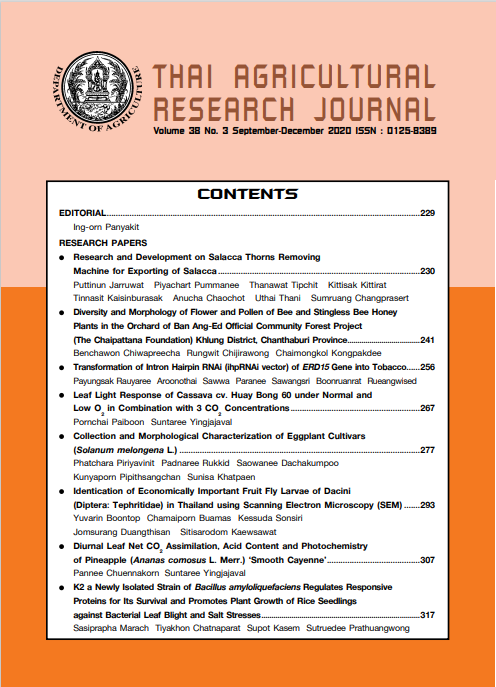Leaf Light Response of Cassava cv. Huay Bong 60 under Normal and Low O2 in Combination with 3 CO2 Concentrations
DOI:
https://doi.org/10.14456/thaidoa-agres.2020.20Keywords:
Cassava, C3 photosynthesis, Light response, Light saturation, PhotorespirationAbstract
The light response functions of cassava cv. Huay Bong 60 were determined under 3 levels of CO2 concentration inside the leaf chamber (Ca) at 400, 800, and 1,200 μmolCO2 mol air-1 to enhance the carboxylation process in combination with 2 levels of O2 concentration at 21% and 2% to suppress the oxygenation process. Results showed that under ambient air (Ca 400 μmolCO2 mol air-1 with 21% O2) cassava leaf had maximum gross photosynthetic rate (Pmax) of 31 μmolCO2 m-2 s-1. The light saturation range was 1,100-1,300 µmolPPF m-2s-1. Maximum electron transport rate (Jmax) was as high as 289 µmol e- m-2 s-1 and maximum photorespiration, (Rp, max) was 12.4 μmolCO2 m-2 s-1. Elevation of Ca could increase Pmax (26-76% increase) more than the lowering of O2 concentration (6-33% increase), as higher Ca enhanced carboxylation as well as suppressed oxygenation. However, the combination of both enabled Pmax to reach 61.2 µmolCO2 m-2 s -1, or 97% increase, coupling with the reduction in Rp and J.
References
พูนพิภพ เกษมทรัพย์ เจษฎา ภัทรเลอพงษ์ เจริญศักดิ์ โรจนฤทธิ์พิเชษฐ์ และเพ็น สายขุนทด.2537. ความสัมพันธ์ระหว่างตำแหน่งใบและอัตราการสังเคราะห์แสงสุทธิของใบมันสำปะหลัง3 พันธุ์. หน้า105-113. ใน:การประชุมทางวิชาการของมหาวิทยาลัยเกษตรศาสตร์ ครั้งที่ 32 สาขาพืช 3-5 กุมภาพันธ์2537
พรชัย ไพบูลย์ พรรณี ชื่นนคร และสุนทรี ยิ่งชัชวาลย์. 2556. พัฒนาการของใบมันสำปะหลังตามลำดับใบ และศักยภาพการสังเคราะห์แสงของใบ. หน้า 1-10. ใน: รายงานโครงการวิจัย. ศูนย์เทคโนโลยีชีวภาพเกษตร มหาวิทยาลัยเกษตรศาสตร์ .
พรชัย ไพบูลย์ และสุนทรี ยิ่งชัชวาลย์. 2559. ปัจจัยสภาพอากาศที่มีผลต่อการเปิดปากใบของมันสำปะหลังพันธุ์ห้วยบง 60. หน้า 7-12. ใน: รายงานโครงการวิจัย. ศูนย์เทคโนโลยีชีวภาพเกษตร มหาวิทยาลัยเกษตรศาสตร์.
พรชัย ไพบูลย์ และสุนทรียิ่งชัชวาลย์. 2563ก.ประสิทธิภาพของกระบวนการตรึง CO2 ในใบมันสำปะหลังและผักโขม. ว.วิจัยและพัฒนา วไลยอลงกรณ์ ในพระบรมราชูปถัมภ์ สาขาวิทยาศาสตร์และเทคโนโลยี 15 (2): 17-27.
พรชัย ไพบูลย์ และสุนทรี ยิ่งชัชวาลย์. 2563ข. การสร้างฐานข้อมูลการสังเคราะห์แสงของพืชเศรษฐกิจเพื่อนำมาใช้ประโยชน์ในการผลิตพืชที่มีประสิทธิภาพ. หน้า 3-5. ใน: รายงานโครงการวิจัย. ศูนย์เทคโนโลยีชีวภาพเกษตร มหาวิทยาลัยเกษตรศาสตร์ .
มูลนิธิสถาบันพัฒนามันสำปะหลังแห่งประเทศไทย.2558. มันสำปะหลัง พันธุ์ห้วยบง 60. เอกสารวิชาการ ฉบับที่ 3/2558. คณะเกษตร มหาวิทยาลัยเกษตรศาสตร์.
วลัยพร ศะศิประภา วิชณีย์ ออมทรัพย์สิน รวีวรรณ เชื้อกิตติศักดิ์ และกุสุมา รอดแผ้วพาล. 2562. การตอบสนองทางสรีรวิทยาบางประการของมันสำปะหลังต่อสภาพแห้งแล้ง. ว. วิชาการเกษตร 37 (1): 93-104.
สุนทรี ยิ่งชัชวาลย์. 2535. ชลศาสตร์ในระบบดิน-พืช. มหาวิทยาลัยเกษตรศาสตร์กรุงเทพฯ. 200 หน้า.
Edwards, G.E., Sheta, E., Moore, B.d., Dai, Z., Franceschi, V.R., Cheng, S.-H., Lin, C.-H., Ku, M.S.B. 1990. Photosynthetic characteristics of cassava (Manihot esculenta Crantz), a C3 species with chlorenchymatous bundle sheath cells. Plant Cell Physiol 31(8): 1199–1206.
El-Sharkawy, M. A., S. M. De Tafur and L. F. Cadavid. 1992. Potential photosynthesis of cassava as affected by growth conditions. Crop Sci 32(6): 1336-1342.
El-Sharkawy, M. A., S. M. De Tafur and L. F. Cadavid. 1993. Photosynthesis of cassava and its relation to crop productivity. Photosynthetica 28: 431-438.
El-Sharkawy, M. A. and S. M. De Tafur. 2010. Comparative photosynthesis, growth, productivity, and nutrient use efficiency among tall- and short-stemmed rain-fed cassava cultivars. Photosynthetica 48(2): 173-188.
Engineer, C., M. Hashimoto-Sugimoto, J. Negi, M. Israelsson-Nordström, T. Azoulay-Shemer, W.-J. Rappel, K. Iba and J. Schroeder. 2016. CO2 sensing and CO2 regulation of stomatal conductance: advances and open questions.Trends Plant Sci. 21(1):16–30.
Farquhar, G.D., S. von Caemmerer and J.A. Berry. 1980. A biochemical-model of photosynthetic CO2 assimilation in leaves of C3 species. Planta 149(1): 78–90.
LI-COR. 2011. Instruction manual for using the LI-6400/LI-6400XT Portable Photosynthesis System, OPEN software version 6.2. LI-COR Biosciences Inc., Nebraska. U.S.A. 1312 p
Taiz, L. and E. Zeiger. 2006. Plant Physiology. 4th ed. Sinauer Associates. 764 p.
Thornley, J. H. M. and I. R. Johnson. 1990. Plant and Crop Modelling. A Mathematical Approach to Plant and Crop Physiology. Oxford Univ. Press, UK. 669 p.
von Caemmerer, S. 2000. Biochemical models of leaf photosynthesis. CSIRO Publishing. 165 p.
Vongcharoen, K., S. Santanoo, P. Banterng, S. Jogloy, N. Vorasoot and P. Theerakulpisut.2018. Seasonal variation in photosynthesis performance of cassava at two different growth stages under irrigated and rainfed conditions in a tropical savanna climate. Photosynthetica56(4):1398–1413.
Xu, Z., J. Yanling, J. Bingrui and Z. Guangsheng. Elevated-CO2 response of stomata and its dependence on environmental factors. Front. Plant. Sci. 7 (657): 1-15.
Yin, X., P. C. Struik, P. Romero, J. Harbinson, J. B. Evers, P. E. L. van der Putten and J. Vos. 2009. Using combined measurements of gas exchange and chlorophyll fluorescence to estimate parameters of a biochemical C3 photosynthesis model: a critical appraisal and a new integrated approach applied to leaves in a wheat (Triticum aestivum) canopy. Plant, Cell & Environment 32(5): 448–464.
Zhu, X.-G., S. P. Long and D. R. Ort. 2008. What is the maximum efficiency with which photosynthesis can convert solar energy into biomass?. Curr. Opin. Biotech. 19 (2): 153–159.
Downloads
Published
How to Cite
Issue
Section
License
Copyright (c) 2020 Thai Agricultural Research Journal

This work is licensed under a Creative Commons Attribution-NonCommercial-NoDerivatives 4.0 International License.
Thai Agricultural Research Journal



